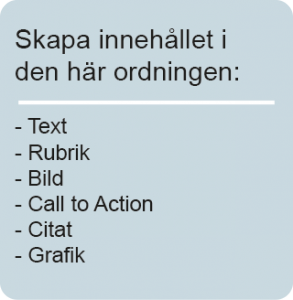
Make sure your content doesn’t just consist of a long block of text, but instead has as many entry points as possible – in different formats.
A text is only truly finished once it’s published, and it’s always satisfying to check something off your to-do list and move on, right? But just because your content is written doesn’t mean it’s complete. Taking the time to pull out key parts of a text—such as quotes or important facts—may take a little extra effort, but it gives you the chance to highlight what’s most important. From the user’s perspective, EVERY different entry point is worth its weight in gold. Because you never really know what the visitor is looking for when they scroll through your website. If you use some of the formats and techniques below to highlight specific content, your page will not only look better but also convert more effectively!
Text
This is probably where you’re already spending most of your time. Creating relevant content is a prerequisite for good results, but it’s smart to let your text rest for a while and then return to see how you can emphasize the most important parts.
Images
A hastily chosen header image at the top of a page is unfortunately very common. But is that enough? Could you add more, smaller images further down the page? Do it!
 Fact Box
Fact Box
Pulling out sections of the text into fact boxes or shorter summaries is a simple trick to keep visitors on the page longer. Or maybe there was a story you didn’t include? Add it in as a “Did you know…”. An excellent place for fact boxes is your right-hand column.
“From the user’s perspective, EVERY different entry point is worth its weight in gold.”
Quotes
Do you have a quote from an expert? Highlighting a quote from your text both draws attention to what’s important and reinforces the softer values of your content in a great way.
Using a style that stands out is one way to highlight something important. Adding colored text in the middle of a text block works wonderfully if there’s something specific you want the visitor to take away from your content.
Tables, Models, and Graphs
Tables can be a bit tricky to create but make reading much easier. Together with models or graphs, they can describe processes or data very effectively and clearly. Remember to add a caption to your table that reinforces what the visitor is seeing.

Bullet Lists
Creating a bullet list with three to five prioritized points makes it easier for the reader to remember key parts.
Quickly copy all the formats here:
* Images
* Fact box
* Quotes
* Colored text
* Tables / charts
* Bullets
* Numbers
Numbers

Enlarging percentages or other key figures can give both your brain and your eyes the break they need.
Call to Action (CTA)
Thinking through the next step for your visitor is important. Do you want them to get in touch, buy a product, or download a report? Whatever it is, make it clear how to proceed and where to do it.
A Guest Post from Brid
This article was written by Fredrik Almgren from the communications agency Brid. You can contact him at Fredrik.almgren@bridagency.se.
